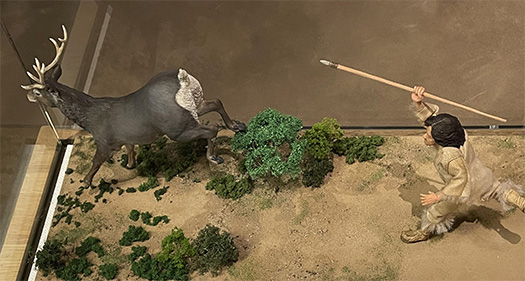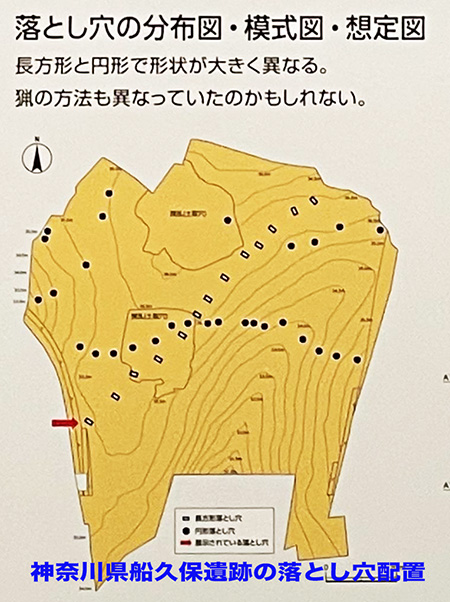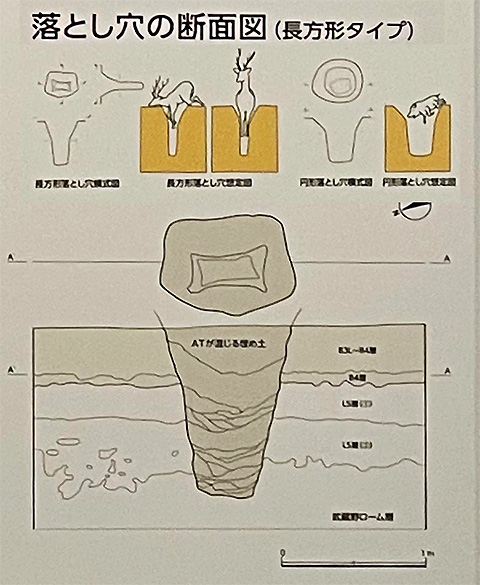

石器時代は動物の狩猟が基本生業であり、生産物確保手段。
日本列島各地にたくさんの遺跡が遺され、
社会としては集落もあり、それぞれの間での交易も活発に展開した。
しかし基本生業が狩猟である以上、その社会密度は対象の絶対数に依存する。
日本旧石器学会が2010年に集計した遺跡データベースによると、日本列島では
旧石器時代と縄文時代草創期の遺跡/文化層の総計は16771。内訳としては
旧石器時代14542と縄文時代草創期2526となる。 重複文化層を1遺跡として
遺跡単位で数えると旧石器時代遺跡が10150、縄文時代草創期遺跡が2432。
およそ22,000年期間の旧石器、13,000年期間の縄文と考えれば、
遺跡の数自体は旧石器遺跡の数は多いと言える。
しかし社会的生産手段の人口維持力を考えれば、集住に適した縄文と
より広域展開が必要だった旧石器というように対比できるのだろう。
現代人はすでにこういう狩猟の経験知、能力を喪失しているが、
たぶんまったく違う能力に「止揚」されて保持しているのだろう。
イラストとジオラマで槍投げでの捕獲と落とし穴猟を比較して考えて見る。
槍での捕獲というのは確率的にどうなのだろうかと思われる。
射手の腕という非科学的な要素で生産効率が左右されざるを得ない。
また獲物の側でも、なんどか危地を脱すると経験知が向上して
より対人類で安全側行動に学習していく可能性が高いと思われる。
「こないだ、仲間がやられたから、もっと注意しよう」と。
一方で落とし穴猟については、より計画的な狩猟が可能だったように思える。


図で示されているように獲物動物の群を人間集団が追い込んで
定置的に待ち伏せすることで、生産効率は高まったのではないか。
またあきらかに個人技の世界から集団知能の世界に地平が変化した。
より戦略的、計画的な知能発達が促進されたのではと思われる。
このあたりの社会的経緯について説明開示されてはいなかった。
言ってみれば「だましのテクニック」だが、こういう動物心理を見抜いて
それを先回りしてコントロールする「工夫」は同時に
対人関係へも応用利用されていったことが容易に考えられる。
社会を操作する知的快感・悪だくみに目覚めるきっかけとして機能したかも。
まぁ、この間37,000年だから類としての知能向上、DNA進化がどれほどかは
よくわからない。しかし現生人類史から言えば半分程度の時間ではある。
この間でどのように進化したのか、その内容はぜひ確認したいと思う。
現生人類の出アフリカはおおむね7-8万年前とされるけれど、
それと対比してもこの列島での経験知蓄積は相当長期だと言えるのでしょう。
そして進化の過程に日本列島の地域性ということも大きく関与した可能性。
一方で、人類は交易を通して相当広範囲に進化を共有したと考えられる。
現実に黒曜石のような鋭利で利用性の高い素材は広範囲に流通した。
そうした情報共有には具体的には「分業」のような機能が働いたかどうか、
交易者というような存在が専門的に知恵の共有に役立ったか。
どんどんと疑問と興味の規模が拡大して止まらない(笑)。・・・
English version⬇
Throwing Spears and Pitfalls The 37,000-Year History of the Japanese Archipelago – 7
The evolution of technology in the Stone Age occupation of hunting. Pitfall hunting brought advanced “deception” techniques and became the basis of “psychological manipulation” technology? …….
In the Stone Age, hunting animals was the basic livelihood and means of securing products.
Many archaeological sites have been found throughout the Japanese archipelago.
There are many archaeological sites throughout the Japanese archipelago, and as a society, there were settlements, and trade between them developed actively.
However, since hunting is the basic occupation, the social density of the society depends on the absolute number of the target population.
According to the archaeological site database compiled by the Paleolithic Society of Japan in 2010, in the Japanese archipelago
The total number of Paleolithic and Pioneer Jomon Period sites/cultural strata is 16771, broken down as follows.
Paleolithic 14542 and Jomon Period 2526. If the overlapping cultural layers are counted as one site, the total number of sites per cultural layer is
The Paleolithic period is 10150 sites and the Jomon period is 2432 sites.
If we consider the Paleolithic period of approximately 22,000 years and the Jomon period of 13,000 years, then the number of sites itself is about the same as the number of Paleolithic sites.
The number of Paleolithic sites itself can be said to be large.
However, considering the ability of the social means of production to sustain a population, the Jomon, which was suited to residential concentration
The Jomon, however, had a social means of production and population maintenance, and the Paleolithic required a wider area of development.
Modern humans have already lost the ability and experience to hunt.
Perhaps they have been “sublimated” into a completely different ability and retained.
Let’s compare spear-throwing and pitfall hunting in the illustration and diorama.
One wonders about the probability of capture by spear.
The production efficiency must be affected by the unscientific factor of the archer’s skill.
Also, on the part of the prey, if it escapes from danger several times, its experiential knowledge will improve, and it will be more likely to act on the safe side with humans.
It is highly likely that the prey will learn to behave more humanely and safely.
The other day, one of my friends got hit, so I’ll be more careful.
On the other hand, for pitfall hunting, it seems that more systematic hunting was possible.
As shown in the figure, a group of humans could drive a group of prey animals into a herd and ambush them in a fixed position.
The production efficiency may have been enhanced by the fixed ambush of a group of prey animals as shown in the figure.
Also, clearly, the horizon has changed from a world of individual skill to a world of collective intelligence.
This may have promoted more strategic and systematic development of intelligence.
The social background of this change was not explained or disclosed.
It is a “trick technique,” if you will.
and controlling it in advance is also applied to interpersonal relationships.
It is easy to imagine that this kind of “ingenuity” to detect and control animal psychology was applied to interpersonal relationships as well.
It may have served as an opportunity to awaken to the intellectual pleasure of social manipulation and deception.
Well, it has been 37,000 years, so I am not sure how much we have improved our intelligence as a species, or how much our DNA has evolved.
I am not sure. However, it is about half of the time in the history of the present human species.
I would like to see how we have evolved during this period.
Although it is said that the first humans appeared in Africa about 70,000 to 80,000 years ago, the history of the present human species is still very different from that of the past.
In contrast to this, the accumulation of empirical knowledge in this archipelago is quite long.
The regional nature of the Japanese archipelago may also have played a significant role in the evolutionary process.
On the other hand, humans are thought to have shared their evolution over a fairly wide area through trade.
In fact, sharp and highly useful materials such as obsidian were distributed over a wide area.
I wonder whether such information sharing involved a specific “division of labor” function.
Did such entities as traders help to share wisdom in a specialized way?
The scale of my questions and interests keeps growing and growing, and I can’t stop (laughs). …
Posted on 10月 12th, 2022 by 三木 奎吾
Filed under: 日本社会・文化研究, 歴史探訪







コメントを投稿
「※誹謗中傷や、悪意のある書き込み、営利目的などのコメントを防ぐために、投稿された全てのコメントは一時的に保留されますのでご了承ください。」
You must be logged in to post a comment.